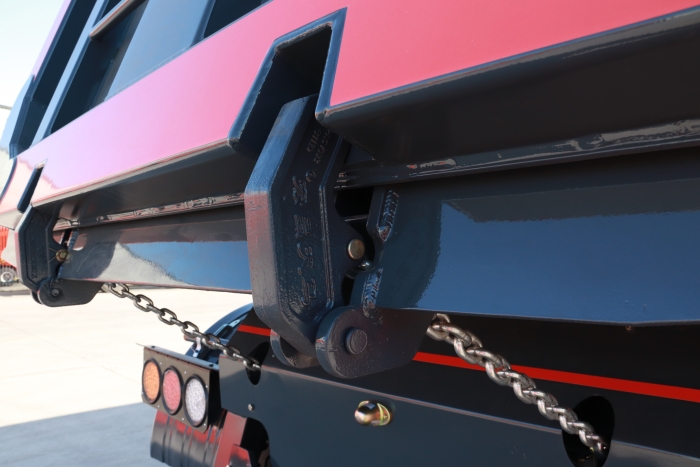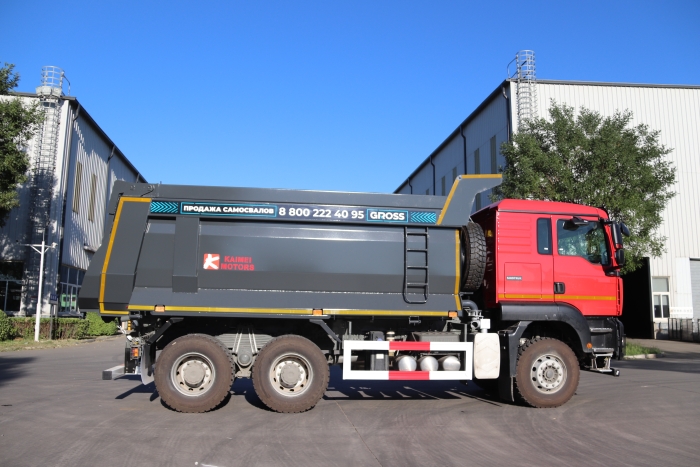- PRODUCTS
- SOLUTION
- SERVICE
- NEWS
- ABOUT US
A fully loaded dump truck typically weighs around 56,000 to 76,000 pounds, depending on the material density and truck capacity.
The weight of a loaded dump truck is an important aspect of the vehicle's regulatory compliance and operational readiness, and a variety of factors contribute to its average weight. In this article, we discuss the main factors that go into the final gross weight of such a vehicle.
Dump Truck Type and Capacity The type and capacity of dump trucks determine their maximum weight carrying potential. A basic example: Being a tandem smorgasbord type of truck it can carry (a standard) 12 to 16 cubic yards of material on it. Being that sand approximately is 2700 lbs per cubic yard, if they were to be carrying sand that would total 32,400 - 43,200 lbs of payload alone.
The loaded weight will very much depends upon material density. Gravel is an example of a dense material and weighs 2,800 pounds per cubic yard. On the other hand, lighter materials like mulch might weigh as little as 500 pounds per cubic yard. The material itself makes a big difference in the total weight when the truck is filled up.
How much is legal limits affecting the load the dump truck carries? With the exception of Maine and Vermont, every U.S. state adheres to the federal bridge gross weight formula, allowing no more than 80,000 pounds (36,000 kg) without a permit. The laws exist so that trucks, which are many tons heavier than the average vehicles may travel safely, without risking the integrity of the road or the safety of the public.

The truck also carries other modifications and equipment which also add to its overall mass. The vehicle can be substantially weighted down with features such as advanced tailgate technology, heavier-duty hydraulics and specialized dump bodies for specific types of materials. For example, lining a dump body for asphalt duty can increase the a truck's empty weight by as much as 800 pounds.
Before talking about the average weight of a fully loaded dump truck, one must take into consideration the kind of the truck as well as its common usage. The weight of the individual truck differs greatly upon the size of the truck and the material carried by it.
Light-duty dump trucks - such as the Ford F-550 - are typically smaller, and weigh less than heavier duty models. Usually, they are capable of carrying 3 to 5 tons of payload. Fully loaded with a material like sand, the total weight (vehicle + load) can reach the 18-20,000-lb. range.
Usually rated 6 to 12 tons, these medium-duty trucks are larger than light-duty but smaller than heavy-duty trucks, this is also the place where the likes of the International 4300 reside. A medium-duty dump truck, in the U.S., is one with a GVWR of between 33001 and 60000 lb (14969 and 27216 kg), totaling 14000 to 26000 lb (6350 to 11793 kg) of curb weight, payload, and passengers. For example, fully loaded the average dump truck can weigh 36,000 pounds or more, and this still falls within the GVWR.
Heavy-duty trucks are for heavy-duty tasks. Heavy Duty Dump trucks like the Mack Granite carries a payload of 13 to 15 tons which is typical. When filled with a heavy material such as wet soil, this adds up to "upwards of 122 thousand pounds", depending on the configuration in question and weight limits in the area.
Dump truck owners should know the legal weight limits of dump trucks to keep the operation safe and legal to avoid fines. In the US, the limits are mainly set by federal and state laws, and may vary greatly across the globe.
The federal weight limit for commercial vehicles on Interstate highways in the U.S. is 80,000 pounds. The limit is specified in order to avoid damage to the accommodation of transportation infrastructure, as well as to ensure security in the highways. This includes the truck, its load and any additional gear. Variations of this type in the axle numbers and the spacing can also change these limits, but they would be determined using the Federal Bridge Gross Weight Formula.
The federal limit is just a standard but states do have the authority to set their own limits for non-Interstate roads. Michigan, for example, permits higher weights because of its industrial requirements and has roads rated for up to 164 000 lbs with permits and configurations. Operators should verify conformity in the printout with the state-specific regulations before planning routes.
Special permits are required for oversized loads, or loads that exceed normal legal limits. These permits include a rigorous vetting and assessing of the route in which the truck will be travelling, the configuration of the truck, and the type of load. For instance, in the case that a heavy load - say a large part for a machine - needs to be transported, a temporary permit can be obtained indicating the exact time and route of transport.
Not each of them are normal or legitimate there, this is unequivocal, but without a doubt, every single one at any rate of the representative practices that twists and seconds ago I have sorted out how to see are, no doubt, solid ways of act It is the law there and there for certain key fundamental reasons as well Road Accidents and Infrastructural Damages due to Overloaded Trucks Non-compliance could also result in hefty fines and legal penalties the operators.
The proper calculation of a fully loaded dump trucks weight is very important to ensure safety, provide better efficiency, and to stay within the legal requirement. Ergo, to make these calculations accurate, you guys need to follow a well-laid plan, here are the steps:

The tare weight of the truck (i.e. the weight of the truck unladen) plays a decisive role in the calculation process. This is the weight of the dump truck in its empty condition. This can be discovered in the owner's manual of the vehicle, on a manufacturer's label inside the truck, or by taking the truck to a certified weigh station. The tare weight of a heavy-duty dump truck is fairly low, relative to its loaded weight, e. g. the tare weight of a common heavy-duty dump truck might lie around 30,000 pounds (15 short tons, 13.5 long tons; thirty short tons when loaded).
Secondly, what is the weight of the material you will transport The creator of dump bed has also based his project on density of material and volume dump bed can contain. For example:
· For sand, your 15 cubic yard load would weigh around 40,500 pounds at a density of roughly 2700 lb/yd^3.
· Gravel: Gravel is also heavier than sand, with a weight of 2,900 pounds per cubic yard. That same 15 cubic yards of gravel would weigh roughly 43,500 pounds.
· This reveals how the choice of material plays a large part in the overall load weight.
Weight varies depending on equipment and modifications done to the truck. For example:
· It is possible that the hydraulic lift systems have added 800 pounds.
· Supported sideboards to provide the loading plane increasing payload up to further 600 pounds
· Be sure to include the weight of each mod when adding them up to make take your numbers are accurate.
The total fully loaded weight can thus be calculated by summing the tare weight, the calculated load weight, and any additional equipment weight. For the above figures if the truck is assumed loaded with gravel
· Tare Weight: 30,000 pounds
· Loaded weight (gravel): 43,500 pounds
· Weight of extra Equipment: + 1,400 pounds (800 + 600)
In for enchanger all-the-time form, 74,900 pounds total fully loaded weight.
Migratory PatternVery often we receive loads that go specifically from point A to point B"And then he changed the direction, "Rodrigues added. "Sometimes, they do not pay attention to the EDL of each axle, the tractive force, the climbing capacity, the vertical load on the hookveyor interface and neglect the deviations...... they may not put a margin of safety to avoid accidental overload. This is also important when you can have a variation of the humidity of the material as wet materials can weight much more than dry materials.
Compliance Checks: Routinely inspect and comply with all federal and local weight regulations so you can avoid fines and maintain road safety. Make sure you are updated with the latest weight rules, especially if you are travelling between different states or regions.
If possible, routine weighing of the full truck should be conducted at certified weigh stations to make sure that the calculations are in exact harmony with real world weights, to make sure the calculations are not too high or low and adjustments made as needed to maintain the practice of compliance and safety.